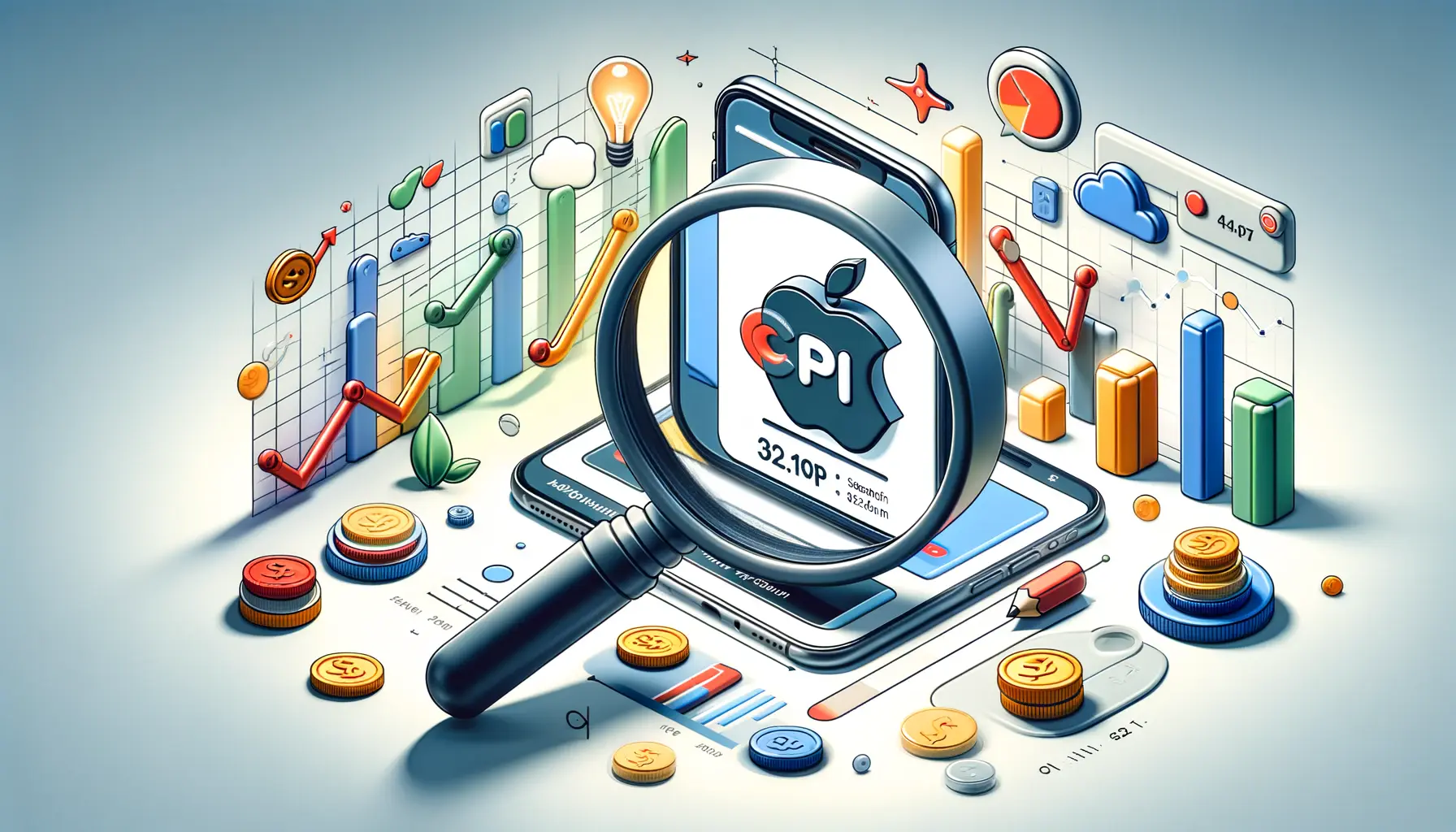The digital advertising landscape is constantly evolving, with each iOS update bringing significant changes that affect how marketers approach campaign structures, especially within the realm of Apple Search Ads.
The introduction of new privacy features and adjustments in user data tracking has necessitated a shift in strategy for advertisers aiming to maintain efficiency and effectiveness in their campaigns.
This article delves into the intricacies of these updates, offering insights into optimizing campaign structures in light of the latest iOS changes.
Understanding the impact of iOS updates on campaign structure is crucial for marketers looking to navigate the complexities of Apple’s ecosystem.
These updates often introduce new features and privacy measures that can significantly influence how campaigns are set up, managed, and optimized.
By staying informed and adapting to these changes, advertisers can ensure their campaigns remain relevant, compliant, and capable of achieving desired outcomes in an ever-changing digital environment.
- Understanding iOS Updates and Their Significance
- Strategic Adjustments in Keyword Targeting
- Enhancing Ad Creatives and Messaging
- Utilizing First-Party Data for Personalization
- Optimizing for the App Store Search Algorithm
- Mastering Bid Strategies and Budget Allocation
- Exploring Advanced Targeting Techniques
- Embracing the Evolution: Navigating iOS Updates in Apple Search Ads Campaigns
- iOS Updates and Their Impact on Apple Search Ads: FAQs
Understanding iOS Updates and Their Significance
The Evolution of iOS Privacy Measures
Recent iOS updates have marked a pivotal shift in how user data is handled, with a strong focus on enhancing privacy and giving users more control over their information.
The introduction of features like App Tracking Transparency (ATT) requires apps to obtain user permission before tracking their activity across other apps and websites.
This change has profound implications for advertisers who rely on such data to target and optimize their campaigns effectively.
The shift towards greater privacy is not just a technical adjustment but a response to growing consumer demand for transparency and control over personal data.
Advertisers must now navigate these changes, understanding that the effectiveness of targeted advertising may be impacted as more users opt out of tracking.
This necessitates a reevaluation of campaign strategies to ensure they remain effective under the new privacy regulations.
Adapting Campaign Structures for Compliance and Efficiency
Adapting to the latest iOS updates requires a strategic overhaul of campaign structures.
Marketers must prioritize transparency and privacy compliance while finding innovative ways to reach their target audience.
This involves exploring alternative targeting methods, such as contextual advertising, which does not rely on personal data, and leveraging first-party data collected with user consent.
Moreover, the importance of optimizing for the App Store’s search algorithm has increased, as traditional ad targeting becomes more challenging.
Advertisers should focus on improving app metadata, including titles, descriptions, and keywords, to enhance visibility and attract organic traffic.
These adjustments can help maintain campaign performance even as the advertising landscape evolves in response to iOS updates.
Embracing change and innovation is key to navigating the impact of iOS updates on campaign structures. By focusing on privacy-compliant strategies and optimizing for organic discovery, advertisers can continue to reach their audience effectively.
Strategic Adjustments in Keyword Targeting
With the advent of iOS updates emphasizing user privacy, the approach to keyword targeting in Apple Search Ads has undergone significant changes.
Advertisers are now tasked with finding a balance between respecting user privacy and achieving campaign objectives.
This section explores the strategic adjustments necessary for effective keyword targeting in this new landscape.
Emphasizing Contextual and Semantic Targeting
The limitations imposed by iOS updates on user data tracking necessitate a shift towards more contextual and semantic targeting strategies.
Unlike behavioral targeting, which relies on historical user data, contextual targeting focuses on the relevance of ad content to the app or website it appears on.
Similarly, semantic targeting leverages the meaning behind user queries and content to serve relevant ads.
These strategies require a deep understanding of the target audience’s interests and behaviors without infringing on their privacy.
- Identify common themes and interests that resonate with your target audience.
- Utilize broad match keywords to capture a wider range of relevant search queries.
- Employ negative keywords to refine targeting and exclude irrelevant traffic.
Optimizing for Apple Search Ads Advanced
Apple Search Ads Advanced offers tools and features that allow for more granular control over ad targeting, making it a valuable asset for advertisers navigating the post-iOS update landscape.
By taking advantage of these features, advertisers can enhance their targeting strategies to better align with the new privacy standards.
- Utilize Search Match feature to automatically match ads to relevant searches based on your app’s metadata and other factors.
- Experiment with different keyword match types (broad, exact, and negative) to optimize campaign reach and efficiency.
- Analyze performance data regularly to adjust bids and refine targeting for optimal results.
Incorporating a mix of contextual, semantic, and advanced targeting strategies can help advertisers maintain effective reach and engagement in the face of iOS privacy updates. By focusing on the relevance and quality of ad placements, rather than relying solely on personal data, campaigns can achieve success while respecting user privacy.
Enhancing Ad Creatives and Messaging
In the wake of iOS updates, the importance of ad creatives and messaging has surged, becoming a critical factor in the success of Apple Search Ads campaigns.
With limitations on data tracking, the ability to capture attention and engage users through compelling ad creatives has never been more essential.
This part delves into strategies for enhancing ad creatives and messaging to resonate with your audience.
Crafting Compelling Ad Copy
Ad copy plays a pivotal role in determining the effectiveness of your campaigns.
It’s the first point of interaction with your audience, making it crucial to convey your message clearly and enticingly.
To craft compelling ad copy:
- Highlight the unique value proposition of your app or product, emphasizing what sets it apart from competitors.
- Use action-oriented language that encourages users to take the desired action, such as downloading an app or making a purchase.
- Keep the copy concise and to the point, ensuring it’s easily readable and understandable at a glance.
Leveraging Visual Elements
Visual elements, including images and videos, significantly impact ad performance by attracting attention and conveying messages quickly.
To leverage visual elements effectively:
- Ensure images and videos are high quality and relevant to the ad’s message, reflecting the app’s or product’s features and benefits.
- Experiment with different formats and styles to determine what resonates best with your target audience, such as lifestyle images versus product screenshots.
- Use A/B testing to compare different creative elements and refine your approach based on performance data.
Optimizing for User Experience
The overall user experience with your ad extends beyond the initial click.
Ensuring a seamless and engaging experience from ad to app is crucial for maximizing conversions.
This includes:
- Ensuring landing pages or app store pages are optimized for conversions, with clear calls to action and easy navigation.
- Maintaining consistency in messaging and design between the ad and the landing page to avoid confusion and drop-offs.
- Regularly updating creatives to keep the campaign fresh and engaging for returning users.
Effective ad creatives and messaging are key to standing out in a crowded marketplace, especially in a privacy-focused advertising environment. By focusing on clear, compelling copy and engaging visual elements, advertisers can create impactful campaigns that drive action and deliver results.
Utilizing First-Party Data for Personalization
As iOS updates enhance user privacy and limit access to third-party data, the importance of first-party data in personalizing and optimizing Apple Search Ads campaigns has grown exponentially.
First-party data, collected directly from your users with their consent, offers a wealth of insights that can be leveraged to tailor campaigns more effectively to individual preferences and behaviors.
Utilizing first-party data effectively requires a strategic approach to data collection, analysis, and application.
This section outlines key strategies for harnessing the power of first-party data to enhance campaign personalization and performance.
Strategies for Collecting First-Party Data
Collecting first-party data involves engaging with your audience through your app, website, and other digital properties.
Effective strategies include:
- Encouraging app downloads and sign-ups through your website to gather user information directly.
- Implementing in-app feedback tools and surveys to collect user preferences and feedback.
- Offering incentives for users to share their data, such as discounts or exclusive content, ensuring transparency about how the data will be used.
Analyzing and Segmenting Data
Once collected, the next step is to analyze and segment this data to uncover actionable insights.
This process involves:
- Using analytics tools to identify patterns in user behavior, preferences, and engagement within your app or website.
- Segmenting your audience based on these insights, such as by demographic information, behavior, or purchase history, to create targeted campaign strategies.
- Regularly updating your segments based on new data to ensure your targeting remains relevant and effective.
Applying First-Party Data to Campaigns
With a clear understanding of your audience segments, you can apply these insights to personalize your Apple Search Ads campaigns.
This includes:
- Customizing ad creatives and messaging to appeal to different segments, enhancing relevance and engagement.
- Adjusting bidding strategies based on the value and behavior of different segments to optimize campaign ROI.
- Using first-party data to inform keyword selection and targeting, ensuring your ads reach the most relevant audience.
Leveraging first-party data allows advertisers to navigate the challenges posed by iOS updates, offering a pathway to personalized, effective campaigns that respect user privacy. By focusing on strategic data collection, analysis, and application, advertisers can unlock the full potential of their campaigns in a privacy-first world.
Optimizing for the App Store Search Algorithm
With the increasing emphasis on privacy and the subsequent limitations on data tracking introduced by iOS updates, optimizing for the App Store’s search algorithm has become a critical strategy for advertisers using Apple Search Ads.
This optimization ensures that your app appears prominently in App Store search results, driving organic downloads and complementing your paid advertising efforts.
Understanding and leveraging the factors that influence the App Store’s search algorithm can significantly enhance your app’s visibility and attractiveness to potential users.
Here’s how to optimize your app for the App Store search algorithm effectively.
Improving App Metadata for Better Visibility
App metadata, including the app title, description, and keywords, plays a crucial role in search visibility.
To optimize your app metadata:
- Choose a descriptive and memorable app title that includes your main keyword.
- Write a compelling description that highlights the unique features and benefits of your app, incorporating relevant keywords naturally.
- Utilize the keywords field to include relevant search terms that potential users might use to find apps like yours.
Enhancing User Experience and Engagement
The App Store’s search algorithm also considers user engagement and satisfaction signals, such as download numbers, user ratings, and reviews.
To enhance user experience and engagement:
- Encourage satisfied users to rate and review your app by integrating prompts within the app experience at appropriate moments.
- Respond to user reviews, addressing concerns and showing potential users that you value feedback and are committed to improving the app.
- Regularly update your app to fix bugs, add new features, and improve performance, which can positively impact user satisfaction and engagement metrics.
Leveraging Visual Assets
Visual assets, including screenshots and videos, not only make your app listing more attractive but can also influence its search ranking.
To leverage visual assets effectively:
- Choose high-quality screenshots that showcase the most compelling features of your app.
- Create an engaging preview video that highlights the app’s functionality and benefits.
- Update your visual assets regularly to reflect new features or use cases, keeping your app listing fresh and engaging.
Optimizing for the App Store search algorithm is an ongoing process that requires attention to detail, creativity, and a deep understanding of your target audience. By focusing on app metadata, user experience, and visual assets, you can improve your app’s visibility and attractiveness, driving organic downloads and supporting your paid advertising efforts.
Mastering Bid Strategies and Budget Allocation
In the evolving landscape of Apple Search Ads, especially with the continuous iOS updates focusing on privacy, mastering bid strategies and budget allocation has become more crucial than ever.
Advertisers must navigate these changes smartly to ensure their campaigns remain competitive and cost-effective.
This part of the article will delve into strategies for optimizing your bidding approach and effectively allocating your advertising budget to maximize campaign performance.
Adapting Bid Strategies for Enhanced Performance
To stay ahead in the competitive environment of Apple Search Ads, adapting your bid strategies is essential.
This involves:
- Employing a mix of manual and automated bidding to maintain control while leveraging Apple’s algorithmic insights for optimization.
- Segmenting campaigns by keyword relevance and competition level, applying more aggressive bids for high-value keywords while maintaining efficiency for broader terms.
- Regularly reviewing bid adjustments based on campaign performance data, market changes, and iOS updates impacts.
Effective Budget Allocation Across Campaigns
Budget allocation plays a pivotal role in the success of your advertising efforts.
Effective budget allocation strategies include:
- Allocating more budget to high-performing campaigns and ad groups, ensuring that your spending aligns with areas that offer the best return on investment.
- Testing different campaign types and ad formats to identify what works best for your target audience, then reallocating budget based on these insights.
- Setting aside a portion of your budget for experimentation with new keywords, creatives, and targeting methods to discover untapped opportunities.
Utilizing Advanced Analytics for Decision Making
Advanced analytics tools can provide deep insights into campaign performance, enabling more informed bid and budget decisions.
Key practices include:
- Integrating Apple Search Ads data with your analytics platform to get a holistic view of user behavior and campaign effectiveness.
- Using attribution modeling to understand the path to conversion, allocating budget to campaigns that play a crucial role in the user journey, even if they don’t directly lead to the final conversion.
- Monitoring industry benchmarks and trends to adjust your strategies in response to broader market changes, ensuring your campaigns remain competitive.
In the dynamic environment of Apple Search Ads, where iOS updates frequently shift the playing field, mastering bid strategies and budget allocation is key to maintaining campaign effectiveness. By staying adaptable, leveraging analytics, and focusing on ROI, advertisers can navigate these changes successfully, ensuring their campaigns continue to thrive.
Exploring Advanced Targeting Techniques
As the digital advertising landscape evolves, particularly with the introduction of privacy-centric iOS updates, advertisers must explore advanced targeting techniques to maintain the effectiveness of their Apple Search Ads campaigns.
These techniques allow for precise audience targeting, ensuring that your ads reach the most relevant users without relying heavily on traditional data tracking methods.
Geographic and Demographic Targeting
Geographic and demographic targeting remain foundational elements of a robust targeting strategy.
By focusing on users’ locations and demographic information, advertisers can tailor their campaigns to specific audiences.
This approach is particularly effective for apps and products that cater to regional preferences or demographic segments.
Implementing geographic and demographic targeting involves:
- Identifying key markets and regions where your app or product has the highest demand or potential for growth.
- Segmenting your campaigns based on demographic data such as age, gender, and income level to match your target customer profile.
- Adjusting ad creatives and messaging to resonate with the targeted geographic and demographic groups, enhancing relevance and engagement.
Behavioral and Interest-Based Targeting
Despite the challenges posed by iOS privacy updates, behavioral and interest-based targeting can still be achieved through the strategic use of first-party data and app analytics.
This technique involves targeting users based on their in-app behavior and expressed interests, offering a personalized advertising experience.
Key strategies include:
- Analyzing in-app user behavior to identify patterns and preferences, such as most-used features or content engagement.
- Creating user segments based on these behaviors and interests, tailoring campaigns to match these segments’ characteristics.
- Employing dynamic ad creatives that automatically adjust based on the user’s past interactions with your app, increasing the ads’ relevance and effectiveness.
Lookalike and Similar Audiences
Lookalike and similar audiences are powerful tools for expanding your reach beyond your existing user base while maintaining a high level of targeting precision.
By identifying users who share characteristics with your best customers, you can extend your campaigns to new, highly relevant audiences.
Effective use of lookalike and similar audiences involves:
- Utilizing your first-party data to define your ideal customer profile, focusing on high-value users who have demonstrated engagement and conversion.
- Working with Apple Search Ads to create lookalike audiences based on this profile, targeting users with similar behaviors and interests.
- Monitoring the performance of campaigns targeting these audiences, refining your ideal customer profile and lookalike audience criteria based on results.
Relying solely on broad targeting methods in today’s privacy-focused digital advertising environment can lead to inefficient ad spend and lower campaign effectiveness. By exploring advanced targeting techniques and leveraging the capabilities of Apple Search Ads, advertisers can achieve precise targeting, driving better results even as the landscape evolves.
Embracing the Evolution: Navigating iOS Updates in Apple Search Ads Campaigns
The landscape of digital advertising, particularly within Apple Search Ads, is in a constant state of flux, driven by ongoing iOS updates and a heightened focus on user privacy.
These changes present both challenges and opportunities for advertisers aiming to optimize their campaign structures for better reach, engagement, and conversion rates.
As we’ve explored throughout this article, adapting to these updates requires a multifaceted approach, incorporating strategic adjustments in keyword targeting, ad creatives, and the use of first-party data, among other tactics.
Key Takeaways for Advertisers
To thrive in this evolving environment, advertisers must focus on several core areas:
- Understanding the impact of iOS updates on user privacy and data tracking, and adjusting campaign strategies accordingly.
- Enhancing ad creatives and messaging to ensure they resonate with the target audience, even in the absence of detailed tracking data.
- Leveraging first-party data to personalize campaigns and maintain relevance with target users.
- Optimizing for the App Store search algorithm to improve organic visibility and complement paid advertising efforts.
- Mastering bid strategies and budget allocation to maximize campaign ROI.
- Exploring advanced targeting techniques to reach highly relevant audiences with precision.
Looking Ahead: The Future of Apple Search Ads Campaigns
The future of Apple Search Ads campaigns in the wake of iOS updates looks both challenging and promising.
Advertisers who embrace the shift towards greater privacy and adapt their strategies accordingly will find themselves well-positioned to engage their target audiences effectively.
This will involve not only a deep understanding of the technical aspects of campaign management but also a creative approach to connecting with users in a more privacy-conscious world.
In conclusion, the impact of iOS updates on Apple Search Ads campaign structure underscores the need for advertisers to be agile, informed, and innovative.
By focusing on the strategies outlined in this article, advertisers can navigate the complexities of the current landscape, ensuring their campaigns remain effective and efficient.
The key to success lies in embracing change, prioritizing user privacy, and continually seeking ways to enhance campaign performance in this dynamic digital advertising environment.
If you're seeking expertise in Apple Search Ads campaigns, visit our service page for professional management!
iOS Updates and Their Impact on Apple Search Ads: FAQs
As iOS continues to evolve, so does its impact on Apple Search Ads. Here are some frequently asked questions to help advertisers navigate these changes effectively.
iOS updates, focusing on user privacy, limit data tracking, requiring advertisers to adapt their targeting and personalization strategies for Apple Search Ads.
ATT is a feature introduced in iOS updates that requires apps to get user permission before tracking their activity across other apps and websites for advertising.
Yes, by leveraging first-party data, contextual and semantic targeting, and optimizing for the App Store search algorithm, effective targeting can still be achieved.
Adapt your bid strategy by employing a mix of manual and automated bidding, focusing on high-value keywords, and regularly reviewing bid adjustments based on performance.
First-party data has become crucial for personalizing ads and targeting users more precisely, especially with the increased privacy restrictions from iOS updates.
Optimize your app by improving app metadata, enhancing user experience and engagement, and leveraging visual assets to improve visibility and attractiveness.
Advanced targeting techniques include geographic and demographic targeting, behavioral and interest-based targeting, and utilizing lookalike and similar audiences.
Maintain effectiveness by focusing on ad creative quality, utilizing first-party data for targeting, and continuously optimizing for the App Store’s search algorithm.














